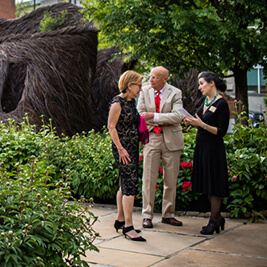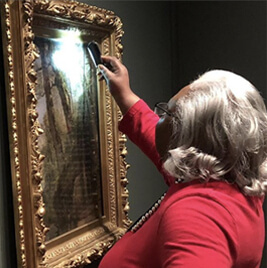- Do + See
- Dine + Host
- Give + Join
- Educate + Learn
The Power of Art and Freedom
A Look at Duncanson's Cincinnati and his Enduring Freedom
by Tamera Lenz Muente, Associate Curator
Taft Museum of Art members and visitors tend to agree: Robert S. Duncanson’s landscape murals make an impression. Each nearly ten feet tall, the eight murals grace the foyer of the historic house, surrounded by trompe l’oeil frames and faux grained woodwork. Painted by Duncanson between 1850 and 1852 as a commission for Nicholas Longworth, then the home’s owner, the spectacular murals don’t reveal what was happening in Cincinnati during the turbulent time of their creation. They also don’t tell us much personally about Duncanson: a man whose grandfather was born enslaved in Virginia, who mostly taught himself to paint, and who became the first internationally recognized Black artist.
When Robert S. Duncanson (1821–1872) arrived in Cincinnati in 1840, he would have encountered Ohio’s Black Laws, intended to slow African American immigration. These laws required Black people entering the state to provide evidence of their free status and to post a bond. Duncanson would not have been able to vote or serve on a jury, and would have lived with the constant threat of violence and intimidation. On multiple occasions, mobs of white workers who believed Black laborers were taking their jobs attacked African Americans, burning their homes and businesses. In 1850, the Fugitive Slave Act enforced the seizure and return of runaway slaves without due process, threatening the safety of all Black people—including Duncanson—as some were abducted and sold into slavery. Still, by the 1850s, Cincinnati was home to one of the largest Black populations in America.
Duncanson didn’t only find discord in Cincinnati. He also engaged with the city’s dedicated abolitionist community. James Birney was publishing his abolitionist newspaper The Philanthropist, despite his printing press being destroyed twice by pro-slavery Cincinnatians. Duncanson met James Presley Ball, an African American photographer who owned a flourishing business; he hand-colored photographs in Ball’s studio, exhibited his paintings in Ball’s gallery, and collaborated with Ball to create a panorama illustrating the history of slavery in the United States. Frederick Douglass visited Cincinnati several times, and it is possible that Duncanson heard him speak or perhaps even met him (Ball photographed Douglass in Cincinnati in 1867).
In 1852, the year Duncanson finished the murals, Harriet Beecher Stowe’s Uncle Tom’s Cabin was published, largely inspired by her earlier experiences in Cincinnati. One year later, Duncanson painted Uncle Tom and Little Eva, which depicted a scene from the novel. He also completed portraits of abolitionists, donated paintings to the cause, participated in protests, and attended anti-slavery lectures. Although existing documents connecting Nicholas Longworth to abolition are scarce, commissioning such an ambitious mural project for his own home from a young Black artist would have sent a message. Longworth provided additional professional support for Duncanson, helping fund the artist’s first journey to Europe and providing a letter of introduction to fellow Cincinnatian Hiram Powers, a sculptor who had already established a studio in Florence, Italy. Longworth called Duncanson “a man of great industry and worth.”
Duncanson rarely represented his attitude toward slavery in his paintings. One exception is View of Cincinnati, Ohio from Covington, Kentucky. In it, he contrasted a Black man working with a scythe and a Black woman hanging laundry with a white man and child strolling in the countryside and other white Kentuckians lounging in the distance. The painting juxtaposes Covington’s agricultural setting with Cincinnati’s urban industry—commerce inextricably tied to the South. In the murals, as in most of his landscapes, Duncanson did not reveal his thoughts about slavery. Or did he? In the mural to the left of the front doors, a group of people participate in a baptism in the river. Might Duncanson have intended these figures to represent African Americans? Did he, as some scholars suggest, use river imagery in his paintings to evoke the yearning for a passage to freedom? We may never know for sure, as he did not write extensively about his work. What we do know is that Duncanson, as a free man, owned his own creative labor and was paid for it. While he painted his moving murals in a white man’s mansion, just across the Ohio River—literally in sight of Longworth’s house—enslaved men, women, and children with skin the same color as Duncanson’s toiled for nothing. That certainly weighed heavily on his mind while he worked.
Near the end of his life, in a letter to his son, Duncanson wrote, “I have no color on the brain, all I have on the brain is paint. . . . I care not for color. Love is my principal, order is the basis, progress is the end.” Let us all take some time to think about Duncanson, about the power of art, and about those whose talents and creativity were never given the freedom to be realized. Let’s make love our principal, and progress our end.






















